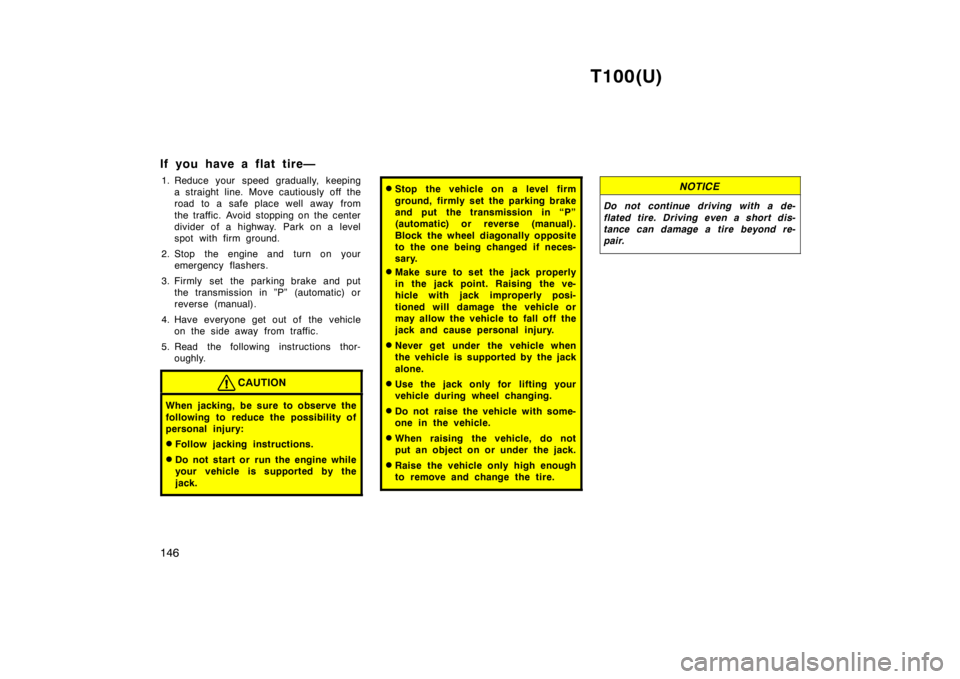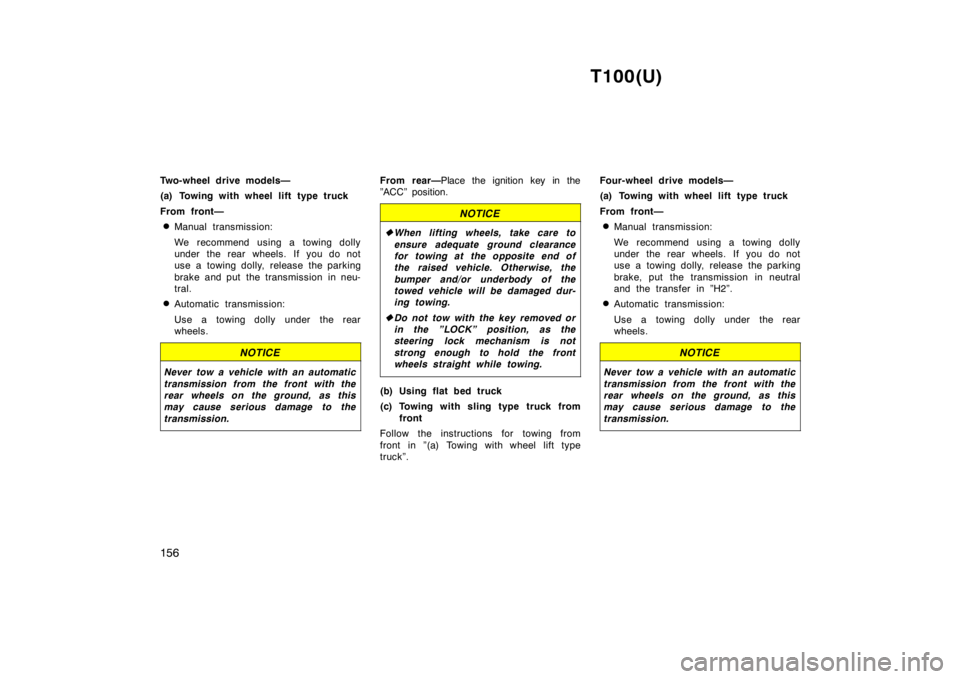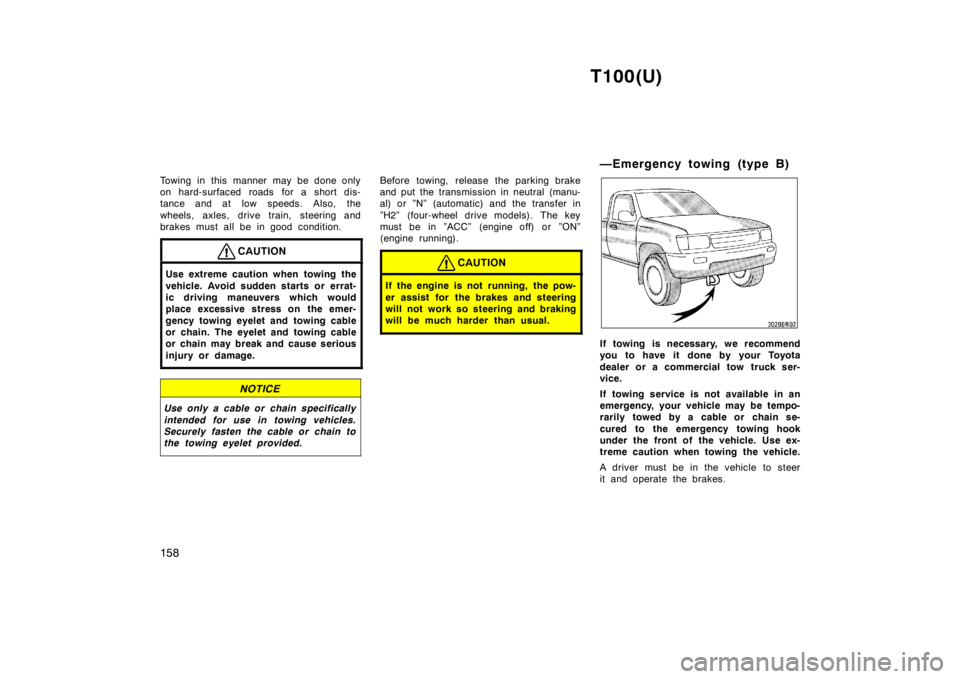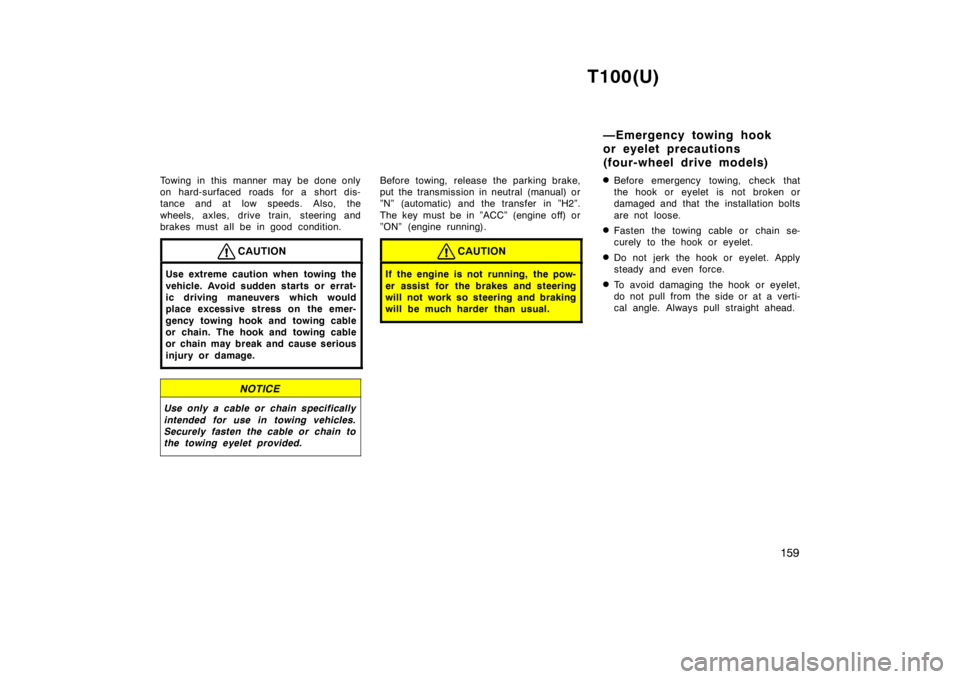1998 TOYOTA T100 parking brake
[x] Cancel search: parking brakePage 145 of 214

T100(U)145
If your vehicle overheats
If your engine coolant temperature
gauge indicates overheating, if you ex-
perience a loss of power, or if you hear
a loud knocking or pinging noise, the
engine has probably over-heated. You
should follow this procedure...
1. Pull safely off the road, stop the ve- hicle and turn on your emergency
flashers. Put the transmission in ”P”
(automatic) or neutral (manual) and ap-
ply the parking brake. Turn off the air
conditioning if it is being used.
2. If coolant or steam is boiling out of the radiator or reservoir, stop the engine.
Wait until the steam subsides before
opening the hood. If there is no coolant
boiling over or steam, leave the engine
running.
CAUTION
To help avoid personal injury, keep
the hood closed until there is no
steam. Escaping steam or coolant is
a sign of very high pressure.
3. Visually check to see if the engine drive belt (fan belt) is broken or loose.
Look for obvious coolant leaks from the
radiator, hoses, and under the vehicle.
However, note that water draining from
the air conditioning is normal if it has
been used.
CAUTION
When the engine is running, keep
hands and clothing away from the
moving fan and engine drive belts.
4. If the engine drive belt is broken or thecoolant is leaking, stop the engine im-
mediately. Call a Toyota dealer for as-
sistance.
5. If the engine drive belt is O.K. and there are no obvious leaks, you may
help the engine cool down more quickly
by running it at about 1500 rpm for a
few minutes with the accelerator pedal
lightly depressed.
6. Check the coolant reservoir. If it is dry, add coolant to the reservoir while the
engine is running. Fill it about half full.
CAUTION
Do not attempt to remove the radiator
cap when the engine and radiator are
hot. Serious injury could result from
scalding hot fluid and steam blown
out under pressure.
7. After the engine coolant temperaturehas cooled to normal, again check the
coolant level in the reservoir. If neces-
sary, bring it up to half full again. Seri-
ous coolant loss indicates a leak in the
system. You s hould have it checked as
soon as possible at your Toyota dealer.
Page 146 of 214

T100(U)
146
If you have a flat tire—
1. Reduce your speed gradually, keeping a straight line. Move cautiously off the
road to a safe place well away from
the traffic. Avoid stopping on the center
divider of a highway. Park on a level
spot with firm ground.
2. Stop the engine and turn on your emergency flashers.
3. Firmly set the parking brake and put the transmission in ”P” (automatic) or
reverse (manual).
4. Have everyone get out of the vehicle on the side away from traffic.
5. Read the following instructions thor- oughly.
CAUTION
When jacking, be sure to observe the
following to reduce the possibility of
personal injury: �Follow jacking instructions.
� Do not start or run the engine while
your vehicle is supported by the
jack.
�Stop the vehicle on a level firm
ground, firmly set the parking brake
and put the transmission in “P”
(automatic) or reverse (manual).
Block the wheel diagonally opposite
to the one being changed if neces-
sary.
� Make sure to set the jack properly
in the jack point. Raising the ve-
hicle with jack improperly posi-
tioned will damage the vehicle or
may allow the vehicle to fall off the
jack and cause personal injury.
� Never get under the vehicle when
the vehicle is supported by the jack
alone.
� Use the jack only for lifting your
vehicle during wheel changing.
� Do not raise the vehicle with some-
one in the vehicle.
� When raising the vehicle, do not
put an object on or under the jack.
� Raise the vehicle only high enough
to remove and change the tire.NOTICE
Do not continue driving with a de-
flated tire. Driving even a short dis-
tance can damage a tire beyond re-
pair.
Page 156 of 214

T100(U)
156
Two-wheel drive models—
(a) Towing with wheel lift type truck
From front—
� Manual transmission:
We recommend using a towing dolly
under the rear wheels. If you do not
use a towing dolly, release the parking
brake and put the transmission in neu-
tral.
� Automatic transmission:
Use a towing dolly under the rear
wheels.
NOTICE
Never tow a vehicle with an automatic
transmission from the front with the
rear wheels on the ground, as this
may cause serious damage to the
transmission.
From rear— Place the ignition key in the
”ACC” position.
NOTICE
� When lifting wheels, take care to
ensure adequate ground clearance
for towing at the opposite end of
the raised vehicle. Otherwise, the
bumper and/or underbody of the
towed vehicle will be damaged dur-
ing towing.
� Do not tow with the key removed or
in the ”LOCK” position, as the
steering lock mechanism is not
strong enough to hold the front
wheels straight while towing.
(b) Using flat bed truck
(c) Towing with sling type truck from
front
Follow the instructions for towing from
front in ”(a) Towing with wheel lift type
truck”. Four-wheel drive models—
(a) Towing with wheel lift type truck
From front—
� Manual transmission:
We recommend using a towing dolly
under the rear wheels. If you do not
use a towing dolly, release the parking
brake, put the transmission in neutral
and the transfer in ”H2”.
� Automatic transmission:
Use a towing dolly under the rear
wheels.
NOTICE
Never tow a vehicle with an automatic
transmission from the front with the
rear wheels on the ground, as this
may cause serious damage to the
transmission.
Page 158 of 214

T100(U)
158
Towing in this manner may be done only
on hard-surfaced roads for a short dis-
tance and at low speeds. Also, the
wheels, axles, drive train, steering and
brakes must all be in good condition.
CAUTION
Use extreme caution when towing the
vehicle. Avoid sudden starts or errat-
ic driving maneuvers which would
place excessive stress on the emer-
gency towing eyelet and towing cable
or chain. The eyelet and towing cable
or chain may break and cause serious
injury or damage.
NOTICE
Use only a cable or chain specifically
intended for use in towing vehicles.
Securely fasten the cable or chain to
the towing eyelet provided.
Before towing, release the parking brake
and put the transmission in neutral (manu-
al) or ”N” (automatic) and the transfer in
”H2” (four-wheel drive models). The key
must be in ”ACC” (engine off) or ”ON”
(engine running).
CAUTION
If the engine is not running, the pow-
er assist for the brakes and steering
will not work so steering and braking
will be much harder than usual.
—Emergency towing (type B)
If towing is necessary, we recommend
you to have it done by your Toyota
dealer or a commercial tow truck ser-
vice.
If towing service is not available in an
emergency, your vehicle may be tempo-
rarily towed by a cable or chain se-
cured to the emergency towing hook
under the front of the vehicle. Use ex-
treme caution when towing the vehicle.
A driver must be in the vehicle to steer
it and operate the brakes.
Page 159 of 214

T100(U)159
Towing in this manner may be done only
on hard-surfaced roads for a short dis-
tance and at low speeds. Also, the
wheels, axles, drive train, steering and
brakes must all be in good condition.
CAUTION
Use extreme caution when towing the
vehicle. Avoid sudden starts or errat-
ic driving maneuvers which would
place excessive stress on the emer-
gency towing hook and towing cable
or chain. The hook and towing cable
or chain may break and cause serious
injury or damage.
NOTICE
Use only a cable or chain specifically
intended for use in towing vehicles.
Securely fasten the cable or chain to
the towing eyelet provided.
Before towing, release the parking brake,
put the transmission in neutral (manual) or
”N” (automatic) and the transfer in ”H2”.
The key must be in ”ACC” (engine off) or
”ON” (engine running).
CAUTION
If the engine is not running, the pow-
er assist for the brakes and steering
will not work so steering and braking
will be much harder than usual.
�Before emergency towing, check that
the hook or eyelet is not broken or
damaged and that the installation bolts
are not loose.
� Fasten the towing cable or chain se-
curely to the hook or eyelet.
� Do not jerk the hook or eyelet. Apply
steady and even force.
� To avoid damaging the hook or eyelet,
do not pull from the side or at a verti-
cal angle. Always pull straight ahead.
—Emergency towing hook
or eyelet precautions
(four-wheel drive models)
Page 167 of 214

T100(U)167
Tire surface and wheel nuts
Check the tires carefully for cuts, damage
or excessive wear. See Chapter 7
−2 for
additional information. When checking the
tires, make sure no nuts are missing, and
check the nuts for looseness. Tighten
them if necessary.
Tire rotation
Rotate the tires every 12000 km (7500
miles). See Chapter 7 −2 for additional in-
formation.
Fluid leaks
Check underneath for leaking fuel, oil, wa-
ter or other fluid after the vehicle has
been parked for a while. If you smell fuel
fumes or notice any leak, have the cause
found and corrected immediately.
Doors and engine hood
Check that all doors including tailgate op-
erate smoothly and all latches lock se-
curely. Make sure the engine hood sec-
ondary latch secures the hood from
opening when the primary latch is re-
leased.
INSIDE THE VEHICLE
Items listed below should be checked
regularly, e.g. while performing periodic
services, cleaning the vehicle, etc. Lights
Make sure the headlights, stop lights, tail
lights, turn signal lights, and other lights
are all working. Check headlight aim.
Service reminder indicators and warning
buzzers
Check that all service reminder indicators
and warning buzzers function properly.
Steering wheel
Be alert for changes in steering condition,
such as hard steering or strange noise.
Seats
Check that all seat controls such as seat
adjusters, seatback recliner, etc. operate
smoothly and that all latches lock securely
in any position. Check that the head re-
straints move up and down smoothly and
that the locks hold securely in any latched
position. For folding
−down seatback
(bench seat), check that the latches lock
security.
Seat belts
Check that the seat belt system such as
buckles, retractors and anchors operate
properly and smoothly. Make sure that the
belt webbing is not cut, frayed, worn or
damaged.
Accelerator pedal
Check the pedal for smooth operation and
uneven pedal effort or catching. Clutch pedal
Check the pedal for smooth operation.
Brake pedal
Check the pedal for smooth operation and
that the pedal has the proper clearance.
Check the brake booster function.
Brakes
At a safe place, check that the brakes do
not pull to one side when applied.
Parking brake
Check that the lever has the proper travel
and that, on a safe incline, your vehicle
is held securely with only the parking
brake applied.
Automatic transmission ”Park” mecha-
nism
On a safe incline, check that your vehicle
is held securely with the selector lever in
”P” position and all brakes released.
IN THE ENGINE COMPARTMENT
Items listed below should be checked
from time to time, e.g. each time when
refueling.
Washer fluid
Make sure there is sufficient fluid in the
tank. See Chapter 7
−3 for additional in-
formation.
Page 203 of 214

T100(U)203
Oil type:
Gear oil API GL −4 or GL −5
Recommended oil viscosity:
SAE 75W −90
AUTOMATIC TRANSMISSION
Fluid capacity (drain and refill),
L (qt., Imp. qt.): Two-wheel drive models Up to 1.6 (1.7, 1.4)
Four-wheel drive models
Up to 2.0 (2.1, 1.8)
Fluid type:
Automatic transmission fluid D−II or DEXRON �
III (
DEXRON �
II)
TRANSFER
Oil capacity, L (qt., Imp. qt.): 1.1 (1.2, 1.0)
Oil type: Gear oil API GL −4 or GL −5
Recommended oil viscosity: SAE 75W −90
DIFFERENTIAL
Oil capacity, L (qt., Imp. qt.): Two-wheel drive models 2.75 (2.9, 2.4)
Four-wheel drive models Front 1.9 (2.0, 1.7)
Rear 2.95 (3.1, 2.6) Oil type:
Hypoid gear oil API GL −5
Recommended oil viscosity: Front SAE 75W −90
Rear
Above −18 °C (0 °F)
SAE 90
Below −18 °C (0 °F)
SAE 80W or 80W −90
CHASSIS LUBRICATION
Wheel bearings: Lithium base wheel bearing grease,
NLGI No.2
Front drive shaft thrust bushings: Synthetic oil and lithium soap base
chassis grease, NLGI No.1
Propeller shafts: Spiders and slide yokes Lithium base chassis grease,
NLGI No.2
Double cardan joint Molybdenum-disulfide lithium base
chassis grease, NLGI No.2
BRAKES
Minimum pedal clearance when depressed
with the pressure of 490 N (50 kgf. 110
lbf) with the engine running, mm (in.): Two-wheel drive models
1-ton models 78 (3.1)
1/2-ton models 73 (2.9)
Four-wheel drive models 1-ton models 70 (2.8)
1/2-ton models 73 (2.9)
Pedal freeplay, mm (in.): 3—6 (0.12—0.24)
Pad wear limit, mm (in.): 1.0 (0.04)
Lining wear limit, mm (in.):
1.0 (0.04)
Parking brake adjustment when pulled with
the force of 196 N (20 kgf, 44 lbf):
11—17 clicks
Fluid type: SAE J1703 or FMVSS No.116 DOT 3
STEERING
Wheel freeplay: Less than 30 mm (1.2 in.)
Power steering fluid type: Automatic transmission fluid DEXRON �
II or III